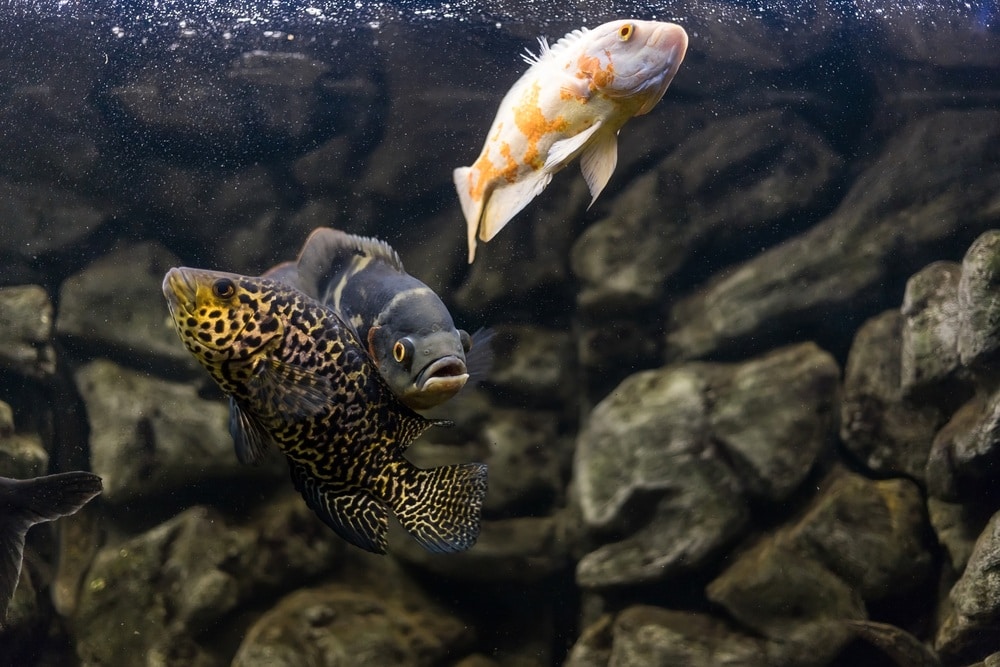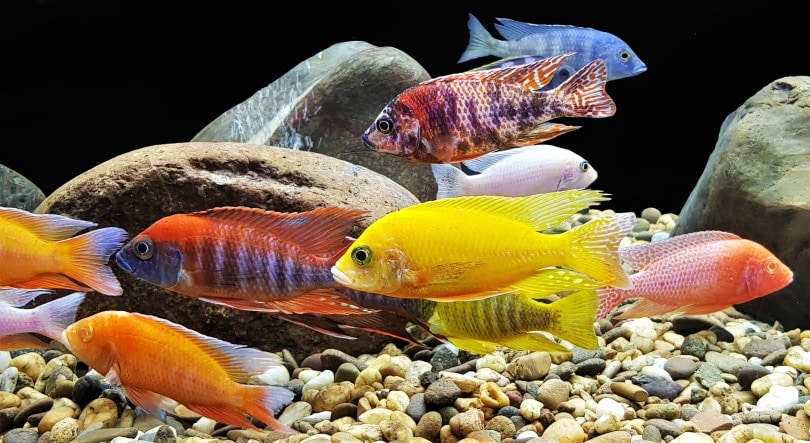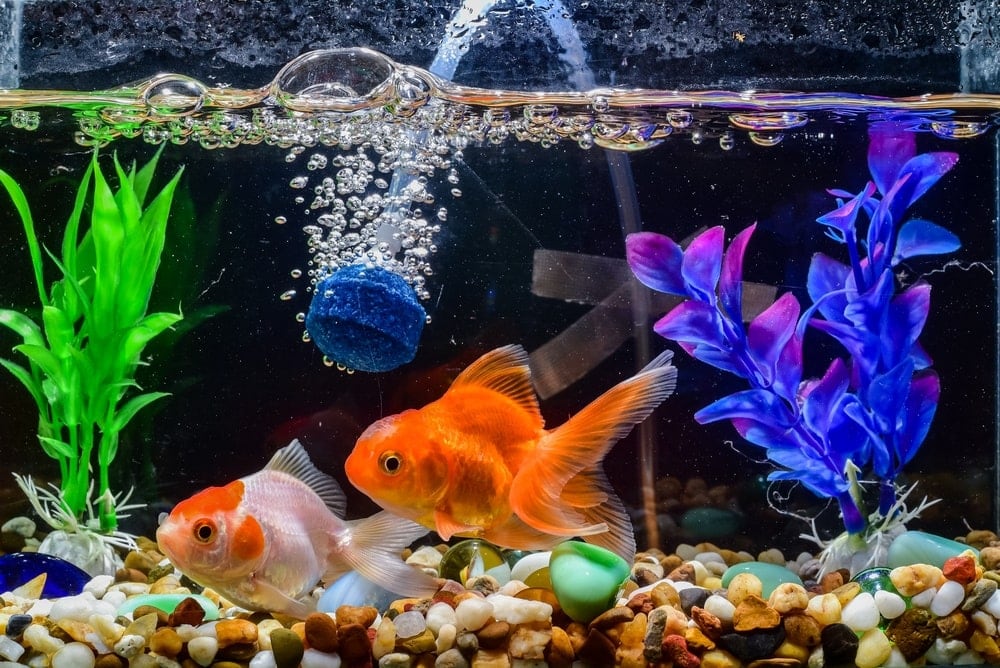Aquarium Banana Plant: Care, Planting & Propagation Tips (With Pictures)

Updated on
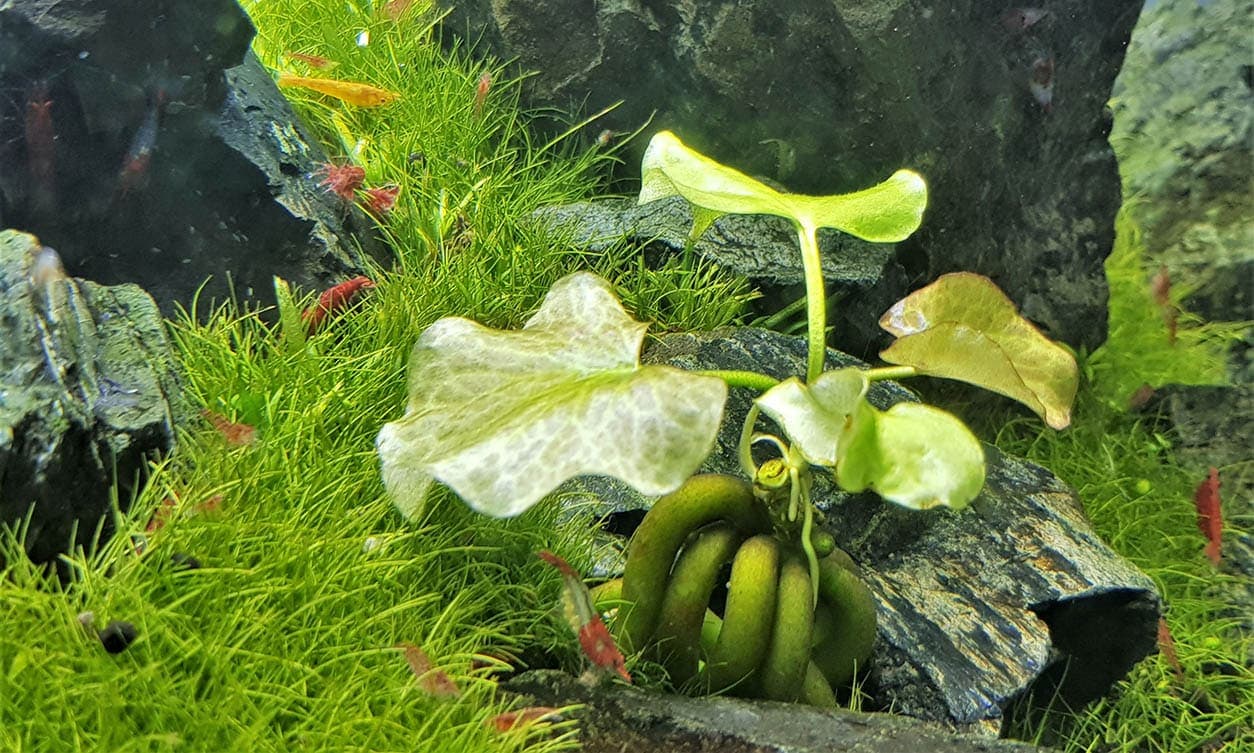
The banana plant is an aesthetically pleasing freshwater foreground plant with an unusual name. The banana plant does not produce actual bananas, much to your dismay. The roots store nutrients while appearing like an underwater bundle of bananas.
- Fairy Water Lily
- Big Floating Heart
- Nymphoides Aquatica
The banana plant grows beautifully and adds a natural and sophisticated look to any aquarium. Aside from the visual aspects, the banana plant is excellent in helping maintain good water parameters. The plant readily absorbs ammonia, nitrites, and nitrates for optimal growth.
A healthy and mature banana plant will have stems that grow to the surface of the aquarium and produce spectacular white flowers that stick out from the waterline.
Quick Summary of the Banana Plant
| Care level: | Beginner |
| Family name: | Menyanthaceae |
| Common name: | Freshwater Banana Plant |
| Origin: | North America |
| Color: | Green |
| Growth rate: | Slow |
| Minimum tank size: | 10 gallons |
| Water conditions: | Freshwater |
| Supplements: | Not required |
| Placement: | Foreground |
| Propagation: | Cut off a leaf and let it float |
| Compatibility: | A variety of low-growing plants |
| Lighting: | Low |
The Appearance of the Banana Plant

The banana plant is an exceptionally eye-catching plant in aquariums. The plant hosts brilliant green leaves with a unique set of tubular roots that look like a bunch of bananas.
A healthy banana plant will have no discoloration in the leaves, no limp stems, and no visual bacterial or fungal growths. Full and thick green leaves indicate a healthy and disease-free banana plant. The color of the leaves will range from dark green to light green with a faint yellow undertone.
Just like the name suggests, the banana plant has roots that sit at the bottom of the stem and are not usually covered by the substrate, depending on the aquarist’s preference. The banana plant adds a unique look to planted aquariums and brings out the liveliness in an aquarium.
As the plant matures, the leaves will gradually darken and become less full to make way for new light green shoots. The tubules at the base of the plant play an important function in the overall health of the plant. Important nutrients are stored in the banana bundled roots, and this fuels the plants and allows them to have access to nutrients when it is required, even if the environment is lacking those nutrients.
The oblong tubers in a healthy banana plant are numerous whiles being thick, green, and in a neat bundle with no discoloration, cracks, or slits. From these tubers, the plant’s roots will grow and deeply root into the substrate.
Buyers Guide: Where to Find It?
Banana plants are not commonly found in most large chain pet stores. The best place to purchase a banana plant would be online from a reputable source. Most pet stores do not stock these plants, as suppliers are hard to find.
Generally, a quality local fish store should stock a few of these beauties. If not, ask your local fish store to check with their supplier if they can get a hold of healthy banana plants. Ask the manager to order more than five plants at a time since this allows buyers to pick out the healthiest banana plant of the bunch.
If you order online, ensure you can track the movements of the plants. Ensure the weather for the week is stable enough for the banana plant to survive shipping. Faster shipping ensures your banana plants will arrive quickly enough for them to take minimal damage during transport. It is overall more ideal to use the fast-shipping option than to be disappointed when you are greeted with a half-dead banana plant.
General Care
The aquarium plant is easy to care for and can withstand many beginner mistakes. Although the banana plant is easy to care for, it still has basic requirements to thrive and survive in its environment. Depriving the plant of appropriate care will result in a very unhealthy and dying aquarium banana plant that will then begin to foul the water and make it dangerous for the inhabitants. Luckily, the care is straightforward and complies with a lot of the same requirements as other low-maintenance freshwater plants.
The banana plant can be placed in a variety of freshwater tank conditions. The roots should either be covered with the substrate with the nutrient storing tubules exposed, or they can be floated. Floating the banana plant will cause it to float sideways. Although it can grow and remain healthy like this, it is not the most attractive way to bring out the best in the plant.
As for all aquatic freshwater plants, the banana plant requires adequate lighting. Ensuring the plant receives at least 6 hours of light is essential. However, do not exceed 12 hours of light, as the inhabitants of the aquarium need darkness to rest, and extreme lighting hours promote overwhelming algae growth.
You can use supplements, such as root tabs, aquatic plant fertilizers, and c02, to promote growth and health in the banana plant. Although supplements are not mandatory, your plant will thank you for its healthy appearance. It is important to not overdo supplementation as too much of a good thing can be a bad thing.
If your banana plant is healthy it will have no discoloration of the leaves, which generally means there is a lack of minerals in the water or the plant is receiving too much or too little light over a long period. The banana plant should have no rotting roots, limp leaves, or abnormally slow growth and development.
Although the banana plant is a slow grower, any unusual signs of slow growth after you have had the plant for a long period is a sign the plant is not receiving adequate care. Meeting the plant’s needs is essential and will be discussed in depth under the following subheading. Once you meet these requirements, you will not have to stress about harming your banana plant. An unhealthy aquatic plant will in return negatively affect the environment.
The Habitat, Tank Conditions & Setup
- Aquarium Size: The banana plant does not grow exceptionally large in a small period. This makes the banana plant suitable for aquariums 5 gallons or above. The plant grows tall and will not overrun a smaller aquarium. The plant is excellent for betta tanks which are minimally 3 to 5 gallons. The banana plant is a great addition to goldfish tanks. Due to the thickness and texture of the leaves, small goldfish will not attempt to consume the plant – a common problem with many other varieties of aquarium plants.
- Filtration: The banana plant requires a standard filter and aeration system to be healthy. Although it is unnecessary if you plan to keep the banana plant in a professional Walsted tank, this is only ideal for seasoned aquarists. Alongside a filtration system, the banana plant is a natural filtration system for the water. Although minimal plants should not be used as a primary filtration system in an aquarium.
- Water pH & Temperature: The banana plant appreciates temperate waters with a temperature of 68° to 82° Fahrenheit. A pH of 6.0-7.2 is ideal. This makes the plant suitable for both cold and tropical water conditions. The banana plant does best in an acidic environment.
- Substrate: Both gravel and sand substrates are suitable for banana plants. The plant is unable to properly root in large pebbles so this should be avoided as a substrate. Note that gravel contains no nutritional additives for the plant, and if fertilizers are not used, the plant will begin to die off. The best substrate option is aquarium sand layered 2 inches deep at the base of the aquarium with root tabs.
- Plant tankmates: The banana plant does well with a variety of both fast and slow-growing plants. The banana plant will happily grow with plants such as Anubias, Hornwort, Java Moss, Java Fern, and the Amazon Sword plant. Do not overcrowd the tank with plants, as this causes them to compete for nutrients and lighting.
- Lighting: The banana plant does well in moderately lit environments. You can choose to use either artificial lighting or natural lighting. For artificial lights, a 2 watt light with a spectrum between 5,000K to 7,000K is ideal.
Tips When Planting
Choosing a desirable space for your banana plant is easy to figure out. The banana plant is small enough to fit into small spaces within the aquarium. The plant may have a hard time staying in the substrate, you can use heavy decorations or plant weights to hold the plant in the substrate. The banana plant tends to naturally float.
If you choose the float the banana plant, ensure the water is rich in minerals, as the plant’s roots will not have a nutrient-rich substrate to absorb for growth. The plant’s leaves should be pointed upright to ensure the leaves can receive adequate lighting.
Another planting option is inside of a heavy glass pot or cup with a nutritional sand substrate. If the plant is having trouble rooting into the substrate and begins to float, you can place washed and aquarium safe pebbles around the base to hold the plant in place.
The 7 Advantages of the Banana Plant in an Aquarium
- The banana plant helps to keep your water in good condition and removes toxic elements from the water, namely ammonia, nitrite, and nitrates produced by the fish or invertebrates.
- The banana plant adds an unusual and interesting plant piece to your aquarium.
- Beginners to the aquatic plant hobby can easily start with the banana plant as a first-time aquatic plant.
- Most species of fish will not attempt to eat the banana plant due to the thickness of the leaves, although this does not include invertebrates like snails.
- The banana plant grows in a simple way which will help you to do an effective health check without having to move intricate growing leaves and stems to see any pests or poor health signs.
- The banana plant provides a resting place for betta fish due to the design of the leaves.
- The plant provides shelter to fish who are sensitive to the lighting in the aquarium.
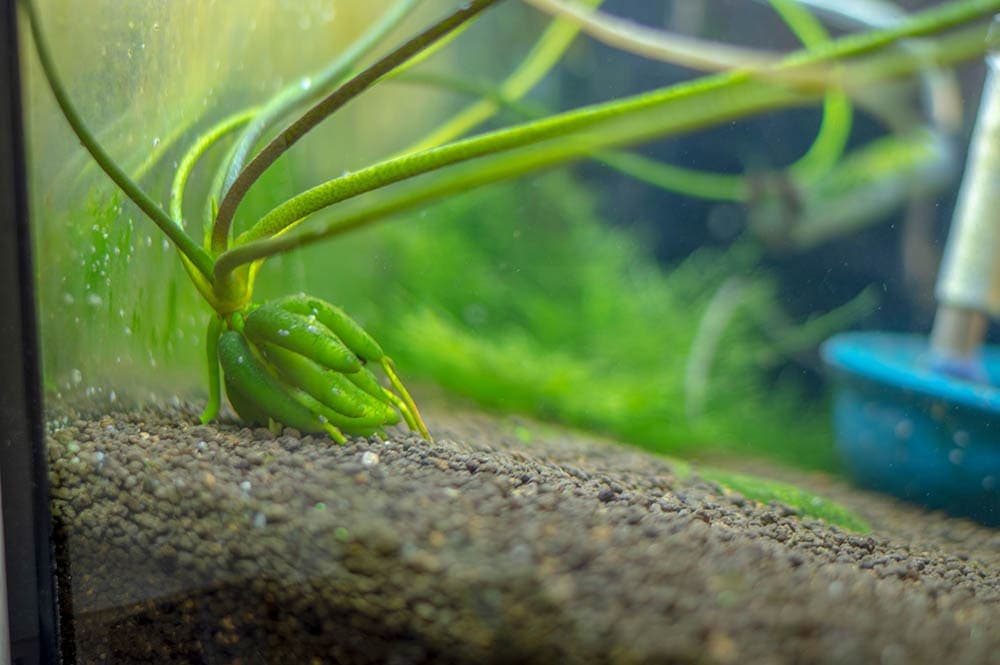
The 4 Concerns About Banana Plants
- Due to the banana plant being hard to acquire, you may have to result in purchasing the plant online. You may find the plant will arrive at you in poor condition, riddled with parasites or pests, and brown or black leaves.
- Some species of fish that can nibble through the thick leafy texture can eat the leaves in minutes. Due to the banana plant having a few leaves at a time with a simple structure, the leaves can easily be eaten completely off the plant.
- The plant may carry diseases that can affect the aquatic life within the aquarium.
- The thin roots may have a hard time staying rooted into the substrate.
Final Thoughts
The banana plant can provide a beautiful aesthetic to your aquarium. The tubular above the roots are unusual and the most desirable physical aspect of this plant. Keeping the banana plant in its correct conditions has a magnitude of advantages. Although this plant is hard to come by, the search and price are worth it!
We hope this article has informed you of everything you need to know about the aquarium banana plant.
Check out some of our other top-trending posts:
- Daphnia Culture: How to Grow Them (Beginner’s Care Guide)
- Costia Disease in Goldfish: Symptoms & Treatment
- Aquarium Plant Problems: Symptoms & Diagnosis
Featured Image Credit: Arunee Rodloy, Shutterstock




